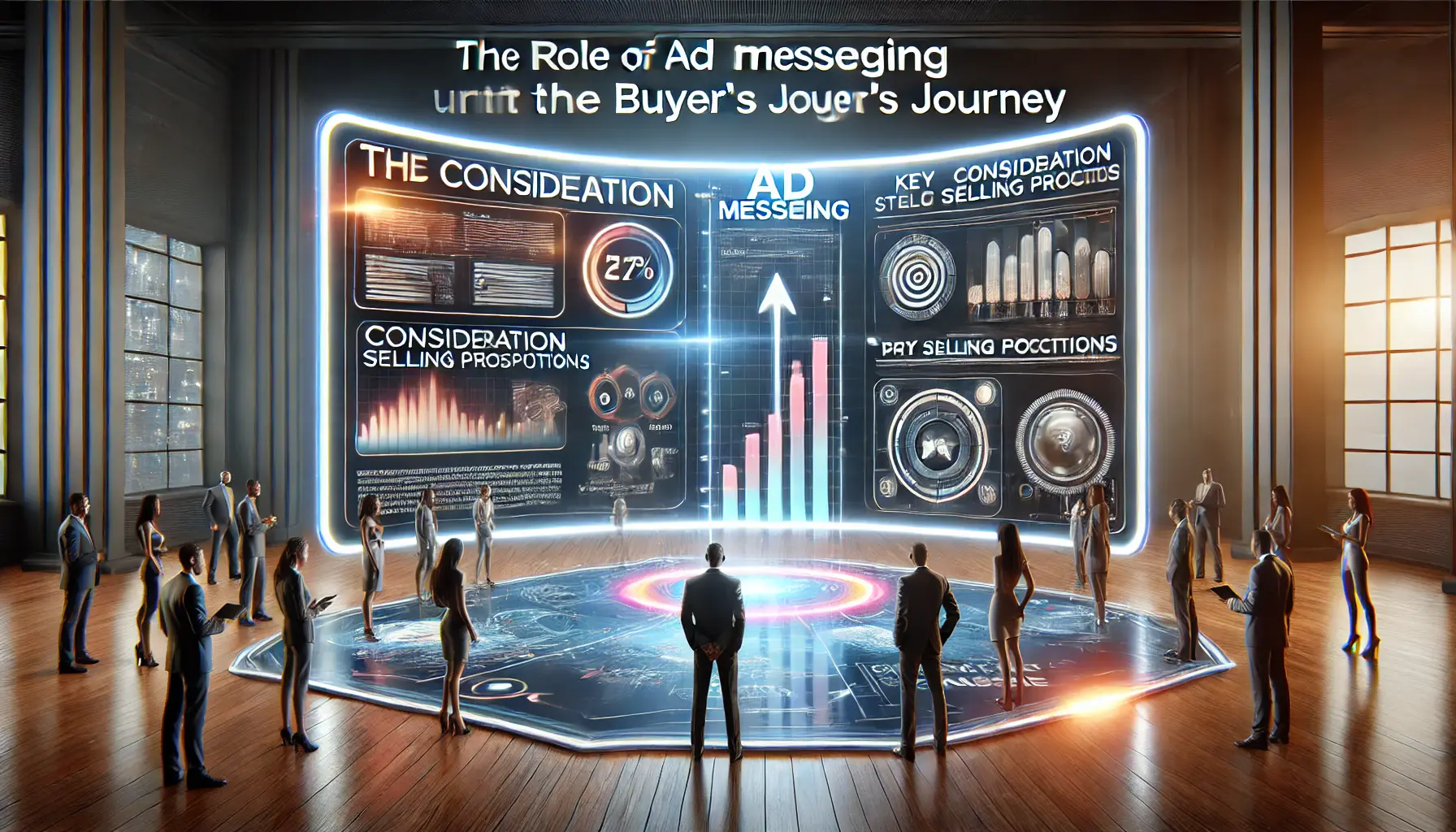In the dynamic world of digital marketing, understanding the buyer’s journey is crucial for crafting effective ad messaging.
One pivotal phase in this journey is the consideration stage, where potential customers actively evaluate their options.
By refining your ad messaging during this phase, you can significantly influence purchasing decisions and steer prospects toward your offerings.
- Understanding the Consideration Stage in the Buyer’s Journey
- Crafting Compelling Ad Messages for Engaged Prospects
- Leveraging Ad Formats to Enhance Engagement
- Personalizing Ad Messaging Through Data Analytics
- Measuring and Optimizing Ad Performance
- Mastering Ad Messaging for the Consideration Stage
- Frequently Asked Questions About Ad Messaging in the Consideration Stage
Understanding the Consideration Stage in the Buyer’s Journey
The consideration stage is a very crucial point in the buyer’s journey.
At this stage, the potential customer has clearly defined their problem or need and is actively researching various solutions.
While in the awareness stage they merely identified their issues, here they are considering various products or services to address their specific needs.
During this stage, your audience is comparing various options, reading reviews, and seeking detailed information to make informed decisions.
They are aware of your brand and are considering whether your offerings align with their needs.
Therefore, your ad messaging should focus on demonstrating how your product or service stands out from the competition and effectively solves their problem.
Defining the Consideration Stage
In this phase, buyers transition from problem identification to exploring available solutions.
They delve into understanding the different approaches to address their needs, weighing the pros and cons of each option.
This is the stage where they form a shortlist of potential products or services, known as the consideration setA shortlist of products or services a buyer evaluates before making a decision., which they will evaluate more closely before making a decision.

Visual representation of ad messaging strategies highlighting their role in guiding prospects during the consideration stage.
The Role of Ad Messaging in This Phase
Ad messaging plays a pivotal role in guiding prospects through the consideration stage.
Effective ad messaging can highlight your unique selling propositionsDistinctive features or benefits that differentiate a product or service from competitors., address common pain points, and provide the information necessary for prospects to move closer to a purchasing decision.
It’s about positioning your brand as the optimal solution among the alternatives they are considering.

Visual representation of key advertising objectives, focusing on engagement and trust-building during the consideration stage.
Key Objectives for Advertisers
During the consideration stage, your advertising objectives should include:
- Educating Prospects: Provide them with all the necessary information on how your product or service can satisfy their specific needs.
- Building Trust: Utilize testimonials, case studies, and reviews to convey credibility and trustworthiness.
- Differentiating Your Brand: Articulate what truly differentiates your offering from the competition.
- Encouraging Engagement: Motivate prospects to take the next step, such as signing up for a webinar, downloading a whitepaper, or starting a trial.
By focusing on these objectives, you can design ad messaging for the consideration stage that naturally aligns the audience toward choosing your product or service over others.
The consideration stage is a turning point in the buyer’s journey where potential customers actively evaluate their options. This is your opportunity to show how your offerings meet their specific needs.

Visual representation of the creative process in crafting compelling ad messages for engaged prospects during the consideration stage.
Crafting Compelling Ad Messages for Engaged Prospects
In the consideration stage, your ad messaging should resonate deeply with potential customers by addressing their specific needs and highlighting what sets your product or service apart.
Let’s explore key strategies to achieve this.

Visual representation of the process of identifying customer pain points through data analysis and feedback.
Identifying Customer Pain Points
Understanding the customer’s pain points is the bedrock of effective ad messaging.
These pain points are specific problems or challenges that your target audience faces.
By identifying these issues, you can tailor your ads to present your product or service as the ideal solution.
To uncover these pain points:
- Conduct Qualitative Market Research: Engage in customer interviews, surveys, and focus groups to understand the problems your audience is trying to solve.
- Analyze Customer Feedback: Review feedback from customer service interactions, social media comments, and online reviews for recurring issues.
- Consult with Customer-Facing Teams: Talk to sales and support teams who interact directly with customers to gain further insights into common concerns.
By thoroughly understanding these pain points, you can create ad messaging that speaks directly to your audience’s needs, positioning your offering as the solution they’ve been seeking.

undefined
Highlighting Unique Selling Propositions
Your Unique Selling Proposition (USP) differentiates your product or service from competitors.
Effectively communicating your USP in ad messaging is crucial during the consideration stage.
To highlight your USP:
- Be Clear and Specific: Clearly state what makes your offering unique and how it benefits the customer.
- Address Customer Needs: Ensure your USP aligns with the identified pain points and desires of your target audience.
- Provide Evidence: Use testimonials, case studies, or data to substantiate your claims and build credibility.
By effectively highlighting your USP, your ad messaging can demonstrate the distinct value your product or service offers, making it more appealing to prospects in the consideration stage.

Visual representation of the importance of incorporating social proof and testimonials in building trust and credibility.
Incorporating Social Proof and Testimonials
Social proof, such as customer testimonials and reviews, plays a significant role in influencing purchasing decisions during the consideration stage.
Incorporating these elements into your ad messaging can build trust and validate the effectiveness of your offering.
Consider the following options:
- Feature Customer Testimonials: Include quotes from satisfied customers that highlight how your product or service solved their pain points.
- Showcase Case Studies: Provide detailed descriptions of how your offering has successfully addressed problems for other clients.
- Highlight Ratings and Reviews: Display positive ratings and reviews from reputable sources to establish credibility.
By integrating social proof into your ad messaging, you reassure potential customers that your product or service provides value and reliability.
This can help them move further along in their buyer’s journey.
Tailor your ad messaging to resonate deeply by addressing customer needs, highlighting unique selling points, and incorporating testimonials to build trust.

Visual representation of leveraging different ad formats like video ads, display ads, and interactive elements to boost engagement.
Leveraging Ad Formats to Enhance Engagement
In the consideration stage, selecting the right ad formats is crucial to capture your audience’s attention and encourage deeper interaction with your brand.
Let’s explore effective ad formats that can elevate engagement during this pivotal phase.

Visual representation of utilizing video ads to create a deeper connection with the audience through emotional storytelling.
Utilizing Video Ads for Deeper Connection
Video ads are a potent way to engage potential customers.
They allow you to showcase a product or service dynamically, making it easier to explain even the most complex information to your audience while emotionally engaging them.
To make video ads really work for you:
- Keep Content Concise: Create videos that run between 15-30 seconds to hold viewers’ interest.
- Focus on Storytelling: Craft a compelling narrative that highlights how your offering addresses customer pain points.
- Include a Clear Call-to-Action (CTA): Encourage viewers to take the next step, such as visiting your website or signing up for a demo.
By implementing these strategies, video ads can effectively move prospects closer to making a purchase decision.

Visual representation of the strategic use of both display and text ads in digital marketing campaigns.
Effective Use of Display and Text Ads
Display and text ads are cornerstones of any well-rounded ad strategy.
They help your message stick and keep your brand top-of-mind as prospects weigh their options.
To further improve engagement with these ads:
- Use Eye-Catching Visuals: Design display ads with high-quality, eye-catching images.
- Craft Compelling Headlines: Write text ads with headlines that clearly state the value proposition.
- Leverage Ad Extensions: Utilize features like site links and call buttons to provide additional information and avenues for engagement.
These practices can increase click-through rates and encourage potential customers to explore your offerings further.

Visual representation of interactive ad elements such as product demos, surveys, and polls being implemented in a marketing campaign.
Implementing Interactive Ad Elements
Interactive ads engage users by allowing them to interact with the content, leading to higher engagement and a more memorable experience.
Consider incorporating the following interactive elements:
- Surveys and Polls: Include short surveys to gather user opinions and increase involvement.
- Product Demos: Provide interactive demos that let users experience your product’s features themselves.
- 360-Degree Views: Give users an immersive view of your product for a better understanding.
By integrating interactive elements, you can create a more engaging ad experience that resonates with potential customers during the consideration stage.
Interactive formats like video ads and product demos can captivate your audience and encourage deeper engagement, especially during the consideration stage.

undefined
Personalizing Ad Messaging Through Data Analytics
In the consideration stage, personalizing your ad messaging can significantly enhance engagement and conversion rates.
Leveraging data analytics allows you to tailor your ads to individual preferences and behaviors, creating a more relevant and compelling experience for potential customers.

Visual representation of collecting and analyzing customer data to inform digital marketing strategies.
Collecting and Analyzing Customer Data
Effective personalization begins with gathering and interpreting customer data.
This process involves:
- Data Collection: Utilize various touchpoints such as website interactions, purchase history, and social media engagement to collect comprehensive data on customer behavior and preferences.
- Data Segmentation: Categorize customers into distinct segments based on shared characteristics or behaviors to deliver targeted ad messaging.
- Behavioral Analysis: Examine patterns in customer interactions to predict future behaviors and tailor ad content accordingly.
By systematically collecting and analyzing customer data, you can gain valuable insights that inform the creation of personalized ad messaging.

Visual representation of implementing dynamic content in digital ads, with real-time personalization based on user behavior.
Implementing Dynamic Content in Ads
Dynamic content allows for real-time customization of ad elements to align with individual user preferences.
To implement dynamic content effectively:
- Utilize Dynamic Creative Optimization (DCO): Employ DCO technology to automatically generate personalized ad variations based on user data and context.
- Include Personalized Product Recommendations: Display products or services in ads that reflect the user’s browsing history or past purchases.
- Contextualize Messaging Based on User Circumstance: Update ad copy and creative to resonate with the user’s current location, time of day, or device used.
Adding dynamic content to your ad messaging ensures that each user gets a unique experience, increasing the likelihood of engagement.

Visual representation of ensuring privacy and compliance in digital marketing, with a focus on data protection and security regulations.
Ensuring Privacy and Compliance
While personalization improves the effectiveness of ads, it is equally important to maintain data privacy and adhere to regulations.
Key considerations include:
- Explicit Consent: Ensure that users have been informed about data collection practices and have provided consent for their data to be used in personalized advertising.
- Follow Data Protection Regulations: Comply with laws such as the General Data Protection Regulation (GDPR) and the California Consumer Privacy Act (CCPA) to protect user data.
- Data Masking/Anonymization: Apply techniques to anonymize personal data in a way that minimizes the risk of identifying a single user while maintaining effective personalization.
By prioritizing privacy and regulatory compliance, you build trust with your audience, which is crucial for running a successful personalized ad campaign.
Integrating analytics data into your ad messaging strategy in the consideration stage allows you to deliver relevant, personalized content that resonates with potential customers, enhances engagement, and drives conversions.
Personalization through data analytics allows you to deliver highly relevant messaging, enhancing engagement while respecting user privacy and compliance.

Visual representation of ensuring privacy and compliance in digital marketing, with a focus on data protection and security regulations.
Measuring and Optimizing Ad Performance
In the consideration stage, it’s crucial to monitor and refine your ad campaigns to ensure they effectively engage your target audience.
By focusing on key performance indicators (KPIs) and employing A/B testing, you can enhance your ad messaging and overall campaign success.

undefined
Key Performance Indicators to Monitor
Tracking the right KPIs provides insights into your ad performance and areas for improvement.
Essential metrics include:
- Click-Through Rate (CTR): The rate at which users click your ad after they see it, which demonstrates the efficiency of your ad copy and how well the ad appeals to the audience viewing it.
- Conversion Rate: The number of ad clicks that actually result in a desired action or outcome, such as a purchase or sign-up, which reflects an ad’s ability to make users take action.
- Cost Per Click (CPC): The average amount spent for each click on your ad, helping assess the financial efficiency of your campaigns.
- Return on Ad Spend (ROAS): It calculates revenue for every dollar spent on advertising, indicating the overall profitability of your ad efforts.
- Quality Score: A metric used by platforms like Google Ads to evaluate the relevance and quality of your keywords and ads, influencing ad placement and cost.
Regularly analyzing these KPIs enables data-driven decisions to optimize your ad messaging and strategy.

Visual representation of A/B testing in digital marketing, comparing two ad variations to optimize performance.
Implementing A/B Testing for Optimization
A/B testing, or split testing, involves comparing two versions of an ad to determine which performs better.
To conduct effective A/B tests:
- Establish Clear Hypotheses: State very specific assumptions of how changes might affect performance, for example, “Changing the headline will improve CTR.”
- Test One Variable at a Time: Only change one element, such as the headline, image, or call-to-action, so that performance differences can be correctly attributed to the change made.
- Ensure Statistical Significance: Run tests with large enough sample sizes to have confidence in which variation performs better.
- Analyze and Implement Findings: Take successful test insights and apply them to your larger ad strategy, continually honing your approach.
By systematically testing and iterating, you can enhance ad effectiveness and better resonate with your target audience.
Monitoring key metrics and A/B testing are two important strategies to consider in refining your ad messaging at the consideration stage.
These practices will allow you to drive more engaging, efficient, and successful advertising campaigns.
Monitoring KPIs like CTR and ROAS, combined with A/B testing, ensures your ad messaging evolves to meet audience needs effectively.

Visual representation of mastering ad messaging strategies to target customer pain points during the consideration stage of the buyer’s journey.
Mastering Ad Messaging for the Consideration Stage
Crafting impactful ad messaging during the consideration stage is an art that requires understanding your audience, leveraging the right tools, and continually optimizing your approach.
Each element, from identifying pain points to refining performance metrics, plays a vital role in engaging potential customers and guiding them toward a purchase decision.

Visual representation of key takeaways for effective ad messaging, focused on analyzing ad performance and improving strategies.
Key Takeaways for Effective Ad Messaging
Here are the most critical strategies discussed in the article:
- Understanding the Buyer’s Journey: Recognize the importance of the consideration stage and tailor your messaging to meet the specific needs of engaged prospects.
- Crafting Compelling Messages: Highlight customer pain points, showcase your unique selling propositions, and integrate social proof to build trust.
- Utilizing Dynamic Ad Formats: Leverage video ads, display ads, and interactive elements to create engaging and memorable campaigns.
- Personalizing Through Analytics: Use data-driven insights to deliver customized messaging that resonates with individual preferences while adhering to privacy regulations.
- Measuring and Optimizing Performance: Monitor key performance indicators and implement A/B testing to continuously improve your ad strategies.

Visual representation of refining ad messaging to improve engagement, customer satisfaction, and conversion rates.
Why Refining Ad Messaging Matters
Ad messaging is more than just words or visuals; it’s a relationship with your audience.
Refining this approach at the consideration stage helps you differentiate in a noisy marketplace while building trust and credibility—key steps toward long-term customer relationships.
As digital marketing evolves, refining your strategies becomes even more important to maintain the efficiency and effectiveness of your campaigns.
Remember: the consideration stage is a critical point for decision-making.
Sending personalized and engaging ad messages at scale can be the key to influencing those decisions in your favor.
By mastering these strategies, you’ll not only enhance your campaign performance but also create lasting impressions that turn prospects into loyal customers.
The investment you make today in sharpening your ad messaging will yield significant rewards in building a stronger, more successful brand tomorrow.
Refining your ad messaging for the consideration stage builds trust and credibility, positioning your brand as the ideal choice in a competitive marketplace.

Visual representation of marketing team addressing frequently asked questions about ad messaging in the consideration stage.
Your campaigns can be managed by an agency specialized in Google Ads, check out our service page.
Frequently Asked Questions About Ad Messaging in the Consideration Stage
Addressing common queries can enhance your understanding of effective ad messaging during the consideration stage.
Here are some frequently asked questions and their concise answers:
The consideration stage is when potential customers have identified their needs and are actively evaluating various solutions to address them.
Effective ad messaging during this stage highlights your product’s unique benefits, helping prospects differentiate your offerings from competitors.
Conduct market research, analyze customer feedback, and engage with sales teams to uncover common challenges your target audience faces.
Incorporating testimonials and reviews builds trust, demonstrating that others have benefited from your product, which can influence purchasing decisions.
Data analytics provide insights into customer behaviors and preferences, allowing you to tailor ad content to individual interests, increasing relevance and engagement.
Utilizing video ads, interactive content, and detailed product showcases can effectively engage prospects by providing in-depth information.
A/B testing allows you to compare different ad elements to determine which resonates best with your audience, enabling data-driven optimizations.
Key Performance Indicators like Click-Through Rate (CTR), Conversion Rate, and Return on Ad Spend (ROAS) help assess ad effectiveness.
Adhere to data protection regulations by obtaining explicit consent and anonymizing personal data to respect user privacy.












